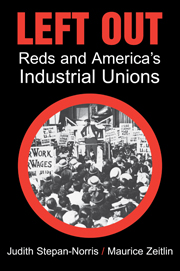Book contents
- Frontmatter
- Contents
- List of Figures and Tables
- Prefatory Note
- Acknowledgments
- Abbreviations
- 1 The Congress of Industrial Organizations: Left, Right, and Center
- 2 “Who Gets the Bird?”
- 3 Insurgency, Radicalism, and Democracy
- 4 Lived Democracy: UAW Ford Local 600
- 5 “Red Company Unions”?
- 6 Rank-and-File Democracy and the “Class Struggle in Production”
- 7 “Pin Money” and “Pink Slips”
- 8 The “Big 3” and Interracial Solidarity
- 9 The Red and the Black
- 10 Conclusion: An American Tragedy
- 11 Epilogue: The “Third Labor Federation” That Never Was
- References
- Author Index
- Subject Index
10 - Conclusion: An American Tragedy
Published online by Cambridge University Press: 28 July 2009
- Frontmatter
- Contents
- List of Figures and Tables
- Prefatory Note
- Acknowledgments
- Abbreviations
- 1 The Congress of Industrial Organizations: Left, Right, and Center
- 2 “Who Gets the Bird?”
- 3 Insurgency, Radicalism, and Democracy
- 4 Lived Democracy: UAW Ford Local 600
- 5 “Red Company Unions”?
- 6 Rank-and-File Democracy and the “Class Struggle in Production”
- 7 “Pin Money” and “Pink Slips”
- 8 The “Big 3” and Interracial Solidarity
- 9 The Red and the Black
- 10 Conclusion: An American Tragedy
- 11 Epilogue: The “Third Labor Federation” That Never Was
- References
- Author Index
- Subject Index
Summary
Communists and their radical allies in the CIO won responsibility and trust in America's industrial unions not by “infiltration” or “colonization” but by an insurgent political strategy: fighting for the cause of industrial unionism and organizing the unorganized for years before the CIO's birth, leading workers' “secessions from below” out of the AFL and into the CIO once it was under way, organizing workers wherever they could and on their own rather than under the tutelage of a CIO organizing committee, and forging coalitions with other cadres of organizers and uniting their forces through amalgamation.
These same insurgent practices, paradoxically, though not in exactly the same way, by producing political variety and organizational diversity, also tended to vitalize the union's inner life and increase the likelihood both that opposition factions would emerge in an international union and that it would be democratic. But even if we take account of the specific insurgent political practices involved in organizing them, the Communist-led international unions continue to stand out as highly democratic. Whether or not earlier Red unionism had taken hold in their industry, whether they seceded from the AFL from below or from above, and whether they were organized independently or under the aegis of a CIO organizing committee, the Communist-led international unions in each of these categories were more likely than their rivals to be highly democratic and far less likely to be oligarchic.
- Type
- Chapter
- Information
- Left OutReds and America's Industrial Unions, pp. 266 - 296Publisher: Cambridge University PressPrint publication year: 2002



